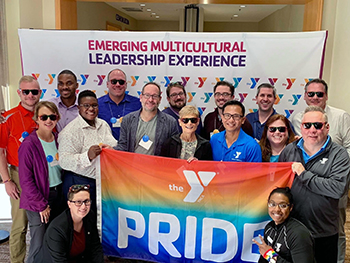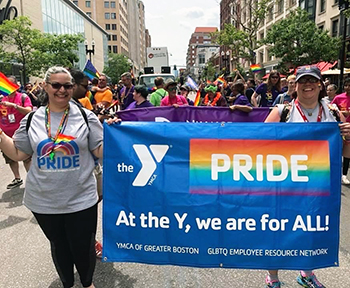intro
Pride Month is traditionally recognized in June by communities across the U.S. to celebrate and support the LGBTQ+ (lesbian, gay, bisexual, transgender, queer, other dimensions of gender identity and allies) community and honor the history of the LBGTQ+ movement.
Why June? On June 28, 1969, customers were socializing at the Stonewall Inn in New York City, which had been patronized mostly by gay men since 1966. However, that night police raided the establishment for unlawful gathering. Patrons began to resist the police harassment and the ongoing persecution of the LGBTQ+ community and a riot broke out. This uprising, known as the “Stonewall Riots” or “Stonewall Uprising,” was one of the initial sparks of the LGBTQ+ movement that we know today.

The purpose of Pride is not just to celebrate, but also to recognize the impact that LGBTQ+ individuals and the community have had on history locally, nationally and internationally. It is also a time for remembrance of those who have lost their lives to hate crimes and HIV/AIDS.
Today, Pride celebrations include parades, picnics, parties and educational forums with events attracting millions across the U.S. and around the world. Ys across the country take part in and host Pride events and activities, often led by their own LGBTQ+ Employee Resource Groups (ERGs) that are supported by YMCA of the USA’s National LGBTQ+ ERG.
Two Powerful Words
How does the Y honor the last two words of its mission statement, “for all?” The Y’s strength is manifested in how it brings together a diverse group of people — no matter their ability, age, cultural background, ethnicity, faith, gender expression, gender identity, ideology, income, national origin, race or sexual orientation.
Bringing people together is what makes the Y a special movement — one that calls us to open our arms widely to welcome all. In doing so, we become more exposed to and educated on the dimensions of diverse experiences, and we begin to celebrate and participate in the sharing of those experiences. Strengthening community includes breaking down barriers and discovering common ground. A healthy, vibrant Y is an inclusive Y.
Bringing people together is what makes the Y a special movement — one that calls us to open our arms widely to welcome all.
Opportunity: Focus on LGBTQ+ Youth
Opportunity: Focus on LGBTQ+ Youth
Recently, more than 12,000 LGBTQ+ teens and young adults participated in an online LBGTQ Teen Survey led by Human Rights Campaign. The survey found that not only are these teens “experiencing heartbreaking levels of stress, anxiety and rejection, but also overwhelmingly feel unsafe in their own school classrooms.” The survey affirmed that having the support of families and adults is foundational to their success and well-being.
Unfortunately, the pandemic has made these outcomes even worse. A recent Trevor Project Survey indicated that 41% of LGBTQ+ youth stated that COVID-19 affected their ability to express their identity, including more than half who identify as transgender or nonbinary. The results, overall, indicated that COVID-19 has negatively impacted mental health and presented these young people with unique challenges, such as stressful living situations.
Collectively, Ys in the U.S. serve more than four million people under the age of 18. The safety and well-being of these young people is foundational to the work Ys do every day across the country. Too many kids and teens make tragic choices when they feel left out or ostracized for being different. We call upon everyone within the Y community to support and intervene against all forms of bullying, particularly when directed at LGBTQ+ kids and teens who are forming their identities and seeking acceptance. The Y is a place where young people who are struggling in any way can be connected to resources and support that will help them navigate their path safely and confidently.
What Can You Do?
Take action by starting with these steps:
- Make your own commitment to address the issues faced by young people who identify as LGBTQ+. Understand that everyone has the responsibility and power to make a difference in a young person’s life—LGBTQ+ or not.
- Ensure that there are inclusive, safe and welcoming spaces for kids, teens and young adults in your community.
- Learn more and access resources from the Gay, Lesbian & Straight Education Network (GLSEN) and the Trevor Project.
- Learn how to address negative behavior toward anyone who is LGBTQ+, including physical (hitting, pushing), verbal (insults, name-calling, threats) and social (gossiping, rumors, ignoring).
- Work with local officials, organizations and youth groups to ensure that policies support the LGBTQ+ community.
- Learn more and access resources from the Human Rights Campaign (HRC).
- Lift up Pride Month throughout June!

YMCA of Greater Boston employees marching in Boston's Pride Parade
Encouraging greater acceptance and support for all, including anyone who identifies or is perceived to be LGBTQ+, will make the communities in which we live safer and more welcoming places for all.
When you see a Pride flag or a newsreel featuring a local Pride parade, know that the LGBTQ+ community is celebrating acceptance and belonging. For some, it might be a time for coming out and, for others like our LGBTQ+ allies, it is an opportunity to demonstrate support for the LGBTQ+ community. We’re all in this together.

